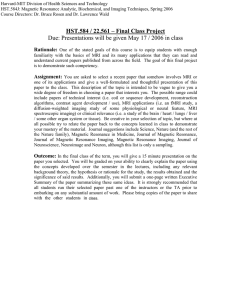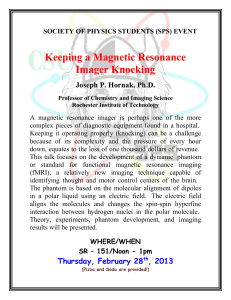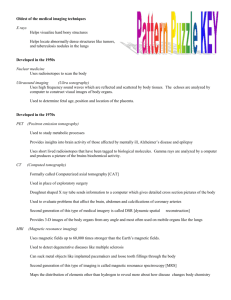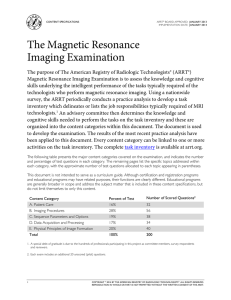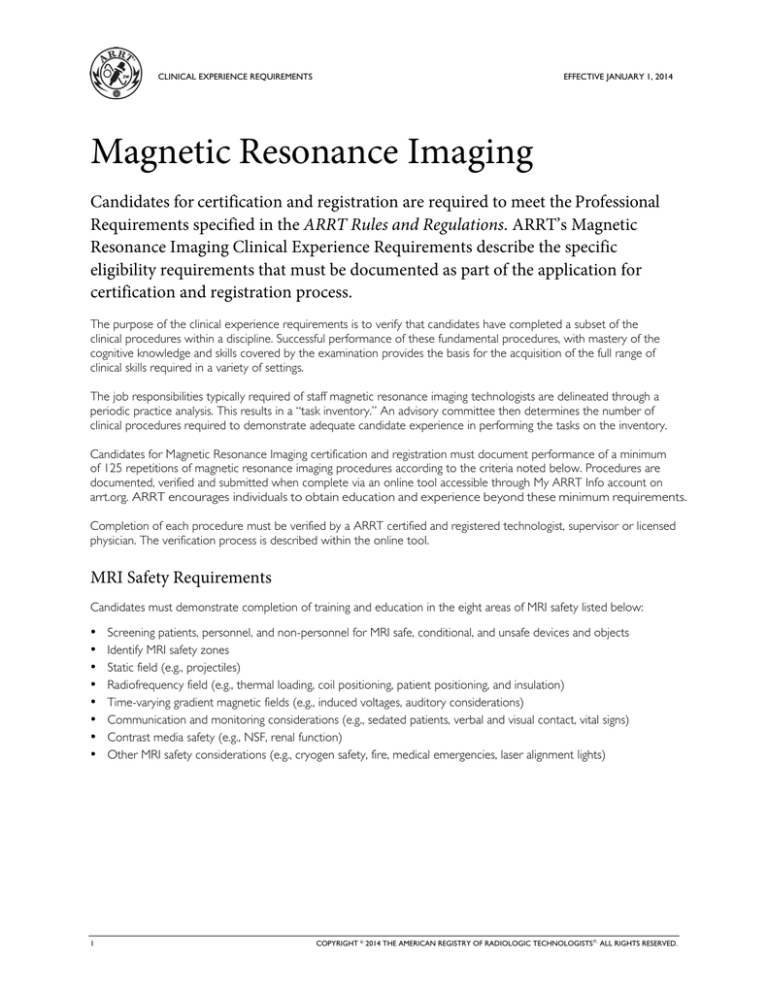
CLINICAL EXPERIENCE REQUIREMENTS
EFFECTIVE JANUARY 1, 2014
Magnetic Resonance Imaging
Candidates for certification and registration are required to meet the Professional
Requirements specified in the ARRT Rules and Regulations. ARRT’s Magnetic
Resonance Imaging Clinical Experience Requirements describe the specific
eligibility requirements that must be documented as part of the application for
certification and registration process.
The purpose of the clinical experience requirements is to verify that candidates have completed a subset of the
clinical procedures within a discipline. Successful performance of these fundamental procedures, with mastery of the
cognitive knowledge and skills covered by the examination provides the basis for the acquisition of the full range of
clinical skills required in a variety of settings.
The job responsibilities typically required of staff magnetic resonance imaging technologists are delineated through a
periodic practice analysis. This results in a “task inventory.” An advisory committee then determines the number of
clinical procedures required to demonstrate adequate candidate experience in performing the tasks on the inventory.
Candidates for Magnetic Resonance Imaging certification and registration must document performance of a minimum
of 125 repetitions of magnetic resonance imaging procedures according to the criteria noted below. Procedures are
documented, verified and submitted when complete via an online tool accessible through My ARRT Info account on
arrt.org. ARRT encourages individuals to obtain education and experience beyond these minimum requirements.
Completion of each procedure must be verified by a ARRT certified and registered technologist, supervisor or licensed
physician. The verification process is described within the online tool.
MRI Safety Requirements
Candidates must demonstrate completion of training and education in the eight areas of MRI safety listed below:
•
•
•
•
•
•
•
•
1
Screening patients, personnel, and non-personnel for MRI safe, conditional, and unsafe devices and objects
Identify MRI safety zones
Static field (e.g., projectiles)
Radiofrequency field (e.g., thermal loading, coil positioning, patient positioning, and insulation)
Time-varying gradient magnetic fields (e.g., induced voltages, auditory considerations)
Communication and monitoring considerations (e.g., sedated patients, verbal and visual contact, vital signs)
Contrast media safety (e.g., NSF, renal function)
Other MRI safety considerations (e.g., cryogen safety, fire, medical emergencies, laser alignment lights)
COPYRIGHT © 2014 THE AMERICAN REGISTRY OF RADIOLOGIC TECHNOLOGISTS. ALL RIGHTS RESERVED.
MAGNETIC RESONANCE IMAGING
EFFECTIVE JANUARY 1, 2014
Specific Procedural Requirements
The clinical experience requirements for MRI consist of 53 procedures in seven different categories. The seven
categories include:
A.
B.
C.
D.
E.
F.
G.
Head and Neck
Spine
Thorax
Abdomen and Pelvis
Musculoskeletal
Special Imaging Procedures
Quality Control
Candidates must document the performance of complete, diagnostic-quality procedures according to the following rules:
• Choose a minimum of 25 different procedures out of the 53 procedures on the following pages.
• Complete and document a minimum of three and a maximum of five repetitions of each chosen procedure; less than
three will not be counted.
• Complete a total of 125 repetitions across all procedures.
• No more than one procedure may be documented on one patient. For example, if an order requests an MRA of the
head and neck for one patient, only one of these, including the post-processing procedures, can be documented for
clinical experience documentation.
General Guidelines
To qualify as a complete, diagnostic-quality MRI procedure, the candidate must demonstrate appropriate:
•
•
•
•
•
•
•
•
•
•
•
•
•
•
•
•
•
•
2
evaluation of requisition and/or medical record
identification of patient
documentation of patient history including allergies
safety screening and patient education concerning the procedure
patient care and assessment
preparation of examination room
preparation and/or administration of contrast media
selection of optimal imaging coil
patient positioning
protocol selection
parameter selection
image display, filming (if applicable), networking and archiving
post-processing
documentation of procedure and patient data in appropriate records
patient discharge with post-procedure instructions
CDC Standard Precautions
MRI safety procedures and precautions
completion of acquisition
MAGNETIC RESONANCE IMAGING
EFFECTIVE JANUARY 1, 2014
General Guidelines (continued)
and evaluate the resulting images for:
•
•
•
•
image quality
optimal demonstration of anatomic region
proper identification on images and patient data
exam completeness
Examples
The hypothetical scenarios below illustrate two ways of satisfying the clinical experience requirements. Numerous other
combinations are possible.
Candidate A: This person who works in a specialized setting wanted to complete the minimum number of
procedures. This person chose 25 different procedures and performed five repetitions of each procedure, for a
total of 125 repetitions.
Candidate B: This person works in a facility that does most types of MRI scans, so completing a wide variety of
procedures was quite feasible. This candidate completed a total of 42 procedures. Although most of these procedures
were performed three times (the minimum), a few of them were performed four or five times each until the candidate
reached at least 125 procedures.
3
MAGNETIC RESONANCE IMAGING
EFFECTIVE JANUARY 1, 2014
Magnetic Resonance Imaging Clinical Experience Requirement Procedures
A. Head and Neck
1. brain
2. IAC
3. orbit
4. pituitary
5. head MRA
6. head MRV
7. cranial nerves
8. posterior fossa
9. head trauma
10. face/soft tissue neck
11. neck MRA
B. Spine
1. cervical
2. thoracic
3. lumbar
4. sacrum/coccyx
5. spinal trauma
6. brachial plexus
C. Thorax
1. chest
2. thoracic MRA
3. breast
D. Abdomen and Pelvis
1. abdomen
2. pancreas
3. kidneys
4. adrenals
5. MRCP
6. abdominal MRA
7. abdominal MRV
8. male pelvis
9. female pelvis
4
E. Musculoskeletal
1. elbow
2. hand/wrist
3. finger/thumb
4. TMJ
5. MR arthrography
6. hip/bony pelvis
7. ankle
8. shoulder
9. scapula
10. sternum/SC
11. foot
12. upper extremity long bones
13. lower extremity long bones
14. knee
F. Special Imaging Procedures
1. image post-processing
(e.g., MIP, MPR, ADC mapping, subtraction)
2. perfusion
3. diffusion (non-brain)
4. CINE (e.g., CSF flow study)
5. peripheral MRA (iliac, runoff)
6. spectroscopy
G. Quality Control
1. signal to noise
2. center frequency
3. transmitter gain or attenuation
4. geometric accuracy
V 2015.05.21


